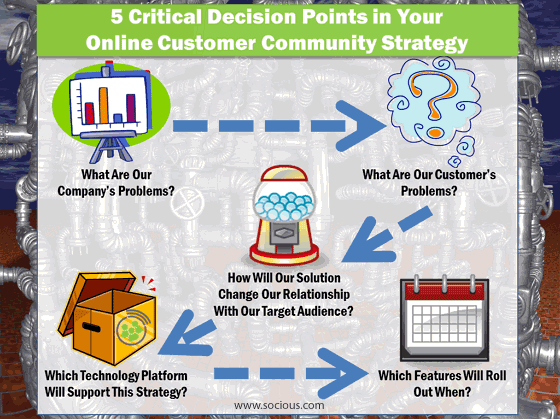Social business is defined as the ability of an organization to use its online communities to improve its performance. These communities could be made up of customers, employees, resellers, journalists, etc. They could be on public social networks or in private online communities.
One of the key groups your business needs to connect with is your customer community. In a time when customers can easily find information about your products, network with others in the industry, and gain insights from competitors online without reaching out to your company, building strong customer relationships is becoming increasingly important.
According to a widely cited report by Frederick Reichheld of Bain & Company, it costs companies an average of 6-7 times more to acquire new customers than it does to retain existing customers.
Customer Communities Are Exhilarating AND Complex
Private, secure customer communities are increasingly becoming an essential tool in how organizations manage customer relationships and leverage those relationships to get more sales, increase retention, and create more innovative products.
Planning, launching, and managing an online community involves complex strategies and dedicated resources. Since social business is new and exciting, companies often struggle to keep everyone involved focused on providing clear value to the company and its customers.
Her are five critical decisions that build on one another to guide your organization toward creating a successful online customer community.
Key Decisions Points in Planning an Online Customer Community
Decision Point #1: What Are Our Problems?
In order to move forward with any social business strategy, an organization must first have a firm grasp the problems that they are trying to solve for the company.
Conduct interviews at various seniority-levels and departments across your company to understand and internalize the business-level problems. Take the time to vet and validate the things that you hear to make sure that they align with your organization’s future plans as well.
Decision Point #2: What Are Our Customer’s Problems?
This critical decision point is the most important determinant of the success of your online community.
Aligning your online community with customer’s most pervasive problems will not only bolster your product strategy, but will keep customers coming back to your community as well (see why this is vital).
Interview and survey customers in person, on the phone and online to gather rich detail about their daily routines, how they use your products or services, and the most challenging parts of their jobs.
Decision Point #3: How Will Our Solution Change Our Relationship With Our Target Audiences?
The main reason for building an enterprise customer community is to improve the relationship between employees, customers, partners, and other stakeholders. This choice focuses on how you will utilize your online customer community and the features offered by the social platform to address your organization’s challenges and your customers’ issues (decision points #1 and #2).
Decision Point #4: Which Platform Will Support This Strategy?
In social business, as in many other business initiatives, technology is only half of the equation. Though strategy, planning, and other non-technology decisions lay the foundation for an online community’s success, the online community software that you implement plays a major role in why your target audience will visit your customer community and how they will stay engaged.
In order to select customer community software that will provide tangible value to your company and customer ecosystem, base your platform evaluation on the problems that you identified earlier and how you plan on solving them. Then, map the way that you are going to change the relationship with your target audience to features such as discussion forums/listservs, event management, mobile apps, and social document libraries.
Decision Point #5: Which Features Will Roll Out When?
Most enterprise online community software includes more features than your employees and customers can initially handle. Rollout and promote only the must-have features that solve your customer’s most urgent problems.
Rolling out more online community features, such as the mobile app or idea management, over time usually involves activating the functionality in the system that is already in place rather than implementing add-ons or a new community platform. Providing the added value to your customers also places your organization the center of the customer hero narrative.
Online Customer Community Takeaway
Private customer communities are quickly becoming a strategic imperative at many mid-sized and large organizations. You can keep the hundreds of decisions that go into the planning and management of your customer community on track and focused on providing business value to your company and customers by answering and sharing upfront the five questions listed above.
The answers to these critical decision points should become part of the project charter, internalized by all team members, consultants, and vendors, as well as get revisited through the online customer community’s lifecycle.

